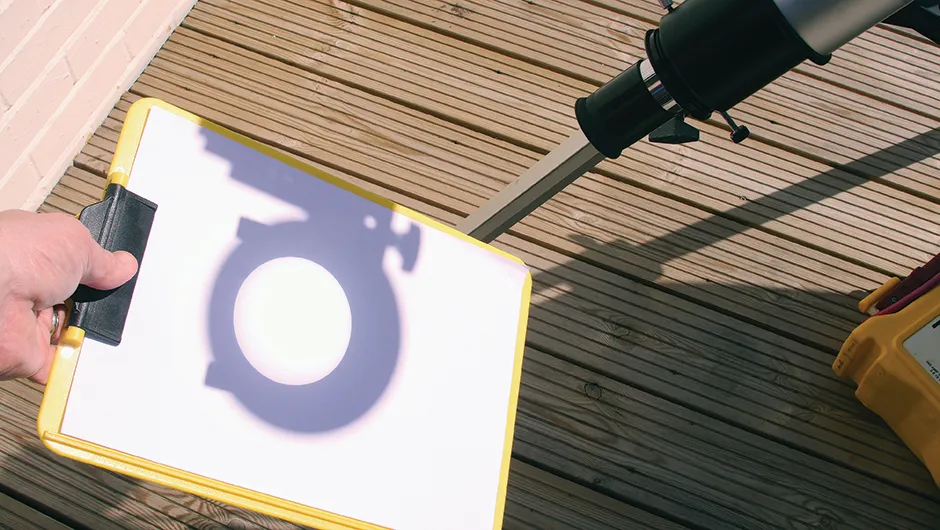A good, safe and easy way of observing the Sun or a solar eclipse is to make a solar projection screen.
The solar projection technique described here can be traced back to Galileo.
Providing care is taken when setting up and supervising the equipment, it's a safe, effective way to enjoy the Sun’s surprising and varied features or a solar eclipse.
The Sun is a seething ball of nuclear reactions, magnetic fields and hot gases, but when you view the surface in normal white light – as you do with a projection screen – you see just the bright surface of the Sun’s photosphere.
This is also a great way of observing a solar eclipse. For more info, read our guide on how to safely observe a solar eclipse.

You should never make direct observations of the Sun with the naked eye or a telescope.
The intense heat can damage your eyesight and equipment.
A solar projection screen is a safe way of observing the Sun or events like a solar eclipse.
In this article, we'll show you how to make one yourself.
Extra materials to help with the build
- Projection screen template (PDF)
- Sun shade template (PDF)
- Support arm template (PDF)
- Solar activity record sheet (PDF)
How a solar projection screen works

The solar projection screen is a flat, lightweight panel supported by two thin rods about 500mm beyond the eyepiece of a refractor telescope.
Light from the Sun is focused by the telescope and eyepiece onto the screen, forming an image about 150mm (6 inches) across.
When you project the solar disc onto the screen you may be lucky enough to see some evidence of the turmoil within.
Sunspots, for instance, slowly traverse across the central regions.
They’re cooler than the surrounding photosphere, making them appear darker. Another feature you may see is faculae.
These bright regions of incandescent gas sometimes precede the formation of sunspots.
The need for a heat shield

Projecting the Sun through your telescope can create a lot of heat.
To keep the telescope’s temperature down you first need to make an aperture reducer, which reduces the amount of light coming into the telescope tube.
Some telescopes are provided with a dust cap with a small opening for this very purpose, but you can make one from cardboard with a hole of about 45mm in diameter cut from the centre.
Simply tape this to the dew shield.
Capturing your solar projection
The Sun’s image should be projected onto a recording sheet – you can print one off from the links at the top of this article.
Clip it to the projection screen with paperclips or clothes pegs so you can trace any sunspots or interesting features with a pencil.
There is also space on the sheet to record useful information such as the date and time, as well as the atmospheric conditions.
The projection screen has two tubes or ‘sliders’ glued into it, allowing it to slide along the rods and ‘zoom’ in and out to create the required size of image that you see on the recording sheet.
The rods are glued firmly at the telescope end into the support arm, which provides a rigid support for the whole unit.
The arm is shaped to fit around the drawtube of your telescope and is also tapered towards the ends to help reduce the weight.
The entire unit is joined to the telescope with a jubilee clip.
These adjustable metal bands are usually used to tighten around hoses and rubber pipes and can be bought from hardware and car accessory shops.
Choose one that will expand to fit around your telescope’s drawtube.
This is the part that holds the eyepiece and it moves in and out when you adjust your focuser.

Tips for building
The trickiest part of the build is drilling two small holes in the jubilee clip so it can be screwed to the support arm; a good way to keep the clip still when you are drilling is to tighten it up onto a round wooden stick first.
This makes it easier to anchor down.
To prevent the metal jubilee clip causing any scratches on the drawtube when you fit it, it’s a good idea to wrap some electrical tape or thin foam padding round the part where the clip will attach.
We found that it was possible to adjust the clip so that we could simply push the unit on and off the telescope when we wanted to use it.

How to use your solar projection screen
Using your finished device is very straightforward.
Look for a good location in your garden or a local park; ideally with a good view of the southern sky, but also sheltered from the wind because the screen acts a bit like a sail and can cause unwelcome vibrations.
Mount the scope on a normal telescope or photographic tripod – you’ll need to extend the legs fully to accommodate the projection screen.
If there are children around make sure you don’t leave the telescope unattended.
Fit your aperture reducer to the front lens of your scope and cover the opening while you aim the telescope towards the Sun.
Point the scope towards the Sun as accurately as you can by making the shadow cast by the telescope onto the Sun shade as small as possible. Switch on the motor drive if you have one and remove the lens cover.
Make fine adjustments so that the Sun’s image falls centrally on the recording sheet.
Focus the image using your scope’s focuser and move the screen back and forth along the dowels until the image fills the 6-inch circle on the recording sheet.
If you can see any sunspots or faculae, use a soft pencil to record their position.
If you repeat this procedure over a number of days you can track the progress and development of sunspots as they rotate around the photosphere – a fascinating and scientifically valuable activity.

Tools and materials
Cardboard: Use an A4 sheet of corrugated cardboard for the projection screen, and a similar sized or larger piece for the Sun shade.
Eyepiece: A low-power eyepiece with a focal length of about 15-20mm works well. Cheap ones are fine, but avoid those with plastic parts or cemented lenses as they can get hot when aimed at the Sun.
Refracting telescope and mount: A small aperture refractor with a medium to long focal length works best. A 60-80mm aperture is fine. This method doesn’t work with a reflector or catadioptric telescope. Whatever the size of your telescope, make a mask from card for the objective lens to reduce its aperture to about 45mm; this will lessen the heat involved. Metal focusers and tubes are better than plastic.
Tools: Use a coping saw for shaping the support arm, a hand drill with suitable bits for the screws and dowels, and a craft knife for cutting cardboard. Use tape and glue to join the parts together.
Wood and dowels: For the support arm you need a piece of softwood about 250 x 50 x 18mm. The two dowel rods are about 8mm in diameter and 600mm long. Use a jubilee clip to fix the support arm to the scope; choose one that matches your drawtube size.
Build a solar projection screen, step-by-step
Step 1

Print off the templates from the links at the top of this article and stick them to stiff cardboard for the projection screen and Sun shade. Carefully cut round them with a craft knife. Stick the support arm template to the piece of softwood.
Step 2

Select a suitable semicircle on the template that suits your drawtube. Cut the shape out with a coping saw or jigsaw and cut the tapering ends to reduce the weight of the arm. You need to drill holes through the markings so the dowels will fit tightly in each end.
Step 3

Fit the jubilee clip into the semicircular cutout by first drilling a small hole about half way along the steel band and then screwing through into the wood. A generous squirt of glue or a second screw will prevent any twisting later on.
Step 4

Roll strips of thin card or paper around the dowel and tape them up to make two sliders. Punch or cut holes in the projection screen and glue the paper rolls into them. These will allow you to slide the screen up and down the dowels to change the image size.
Step 5

Glue the dowels into the support arm and slide on the projection screen. Wrap a strip of foam or tape some fabric around the drawtube to prevent any scratching. Fit the unit onto the scope and tighten the jubilee clip onto the foam padding.
Step 6

Make a cardboard aperture reducer with a 45mm hole. Clip a recording sheet onto the projection screen. Line up the scope, remove the cap, focus and start observing. Clip a curved sheet of paper to the dowels to create more shade if required.
Did you make our solar projection screen? We’d love to see it! Get in touch via contactus@skyatnightmagazine.com.
This How To appeared in the June 2009 issue of BBC Sky at Night Magazine.
